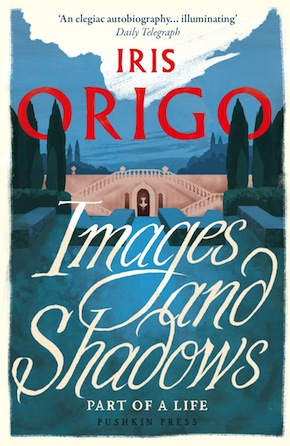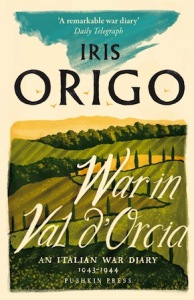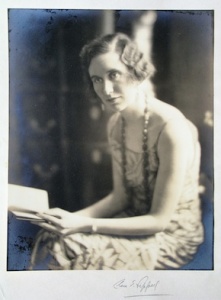Seduced by utopia
by Mika Provata-Carlone “Now do tell me – what does it feel like to wake in the morning on a Tuscan farm?” Virginia Woolf asked a much younger Iris Origo in 1935. Invited to stay for tea at the Tavistock Square flat above the Hogarth Press, Origo, we may assume, obliged with a beautifully eloquent answer – after all, Woolf was her idol, and Hogarth was about to publish her very first book, a biographical sketch of Allegra, Lord Byron’s daughter. Woolf was utterly entranced; later, she would even teasingly confess to having fallen in love with the “charming Marchesa Origo”, adding mischievously that she knew she did not stand a chance against the fierce competition. Generations of friends and visitors would also fall under the spell of the otherworldly, enchanted realm of La Foce, the Tuscan estate Origo would literally conjure up out of nothingness with her Italian husband, the Marchese Antonio Origo. “The country is wild and lonely: the climate harsh” was Origo’s initial assessment, and this wildness, and rugged solitude, were undeniably the location’s irresistible seduction and allure.
“Now do tell me – what does it feel like to wake in the morning on a Tuscan farm?” Virginia Woolf asked a much younger Iris Origo in 1935. Invited to stay for tea at the Tavistock Square flat above the Hogarth Press, Origo, we may assume, obliged with a beautifully eloquent answer – after all, Woolf was her idol, and Hogarth was about to publish her very first book, a biographical sketch of Allegra, Lord Byron’s daughter. Woolf was utterly entranced; later, she would even teasingly confess to having fallen in love with the “charming Marchesa Origo”, adding mischievously that she knew she did not stand a chance against the fierce competition. Generations of friends and visitors would also fall under the spell of the otherworldly, enchanted realm of La Foce, the Tuscan estate Origo would literally conjure up out of nothingness with her Italian husband, the Marchese Antonio Origo. “The country is wild and lonely: the climate harsh” was Origo’s initial assessment, and this wildness, and rugged solitude, were undeniably the location’s irresistible seduction and allure.
Iris Origo was perhaps one of the last members of a fading race: a scion of formidable genealogies on both sides of the Atlantic that combined almost mythical prosperity with the new force on the rise in the early 20th century: the eccentricity of the individual. Her paternal grandfather had been a diplomat and wealthy New York philanthropist, a founding member of the New York Public Library and the Metropolitan Opera, as well as being a close friend of Edith Wharton, who is said to have situated her Age of Innocence at his Westbrook mansion. Her father was a pupil of Santayana at Harvard, who had taught T.S. Eliot, Robert Frost and Gertrude Stein, and counted Wallace Stevens as his friend. The young William Bayard Cutting would be imbued with his professor’s humanism, pragmatism, the dream of an idealised cosmopolitanism. On her mother’s side, Origo was the granddaughter of the 5th Earl of Desart, the Irish statesman and peer who is said to have sought to delay Oscar Wilde’s trial to allow him time to escape to France (Wilde turned down the offer). Having lost her father at a very early age, Origo grew up “somewhere where she [did] not belong”, according to her father’s wishes. The place of ‘non-belonging’ chosen by her mother, the rather eccentric and colourful Lady Sybil, was none other than the no less fabled Villa Medici in Fiesole, Florence. Henry James was a visitor, as was Bernard Berenson, their neighbour in Villa I Tatti nearby, as were most of the more or less Italianised expats colonising various parts of Italy at the time, or their visitors, such as Oscar Wilde, Aldous Huxley, Mario Praz, Anatole France, Vanessa Bell, Harold Nicolson.
Origo had an enviable childhood in some ways: she was surrounded by breathtaking beauty, material and intellectual richness, engrossing cultural perspectives, belonging to a social milieu of myriad layers, family stories, prospects and indisputable power. This mesmerisingly advantaged beginning to life is something she acknowledges fully and evocatively in her autobiographical Images and Shadows, where she also describes the sense of alienation, unnaturalness, rootlessness and isolation that accompanied the splendour and the magic of those years. In her wartime diary, War in Val d’Orcia, she would later call this particular combination of absence and presence from the realm of ordinary existence the “barrier of privilege” – which shielded her from a greater awareness of the course of history, and deprived her of sharper clarity regarding political realities and actual events during the years of Fascist supremacy.
She possesses natural elegance as well as a subtle sense of humour, whether she is reminiscing about the images and shadows of her childhood or remembering stark scenes from the Second World War.”
One might well describe Iris Origo as the perfect incarnation of a Jamesian heroine who has attained that most elusive of Jamesian sacred chalices: a certain kind of happiness. Educated at home by the Dante scholar Solone Monti and by French and German governesses, unable to attend university yet possessing a meticulously trained, very precise mind, Origo would nonetheless escape the grand ball and circuit of women like her and of her time. Her marriage to a minor Italian aristocrat with an equally untypical background (Antonio Origo’s father, Marchese Clemente Origo, was a celebrated sculptor and graphic artist) heralded an escape into a world as much a figment of the imagination as a terrific wager against realistic impossibility. The Origos bought extensive stretches of land in the most un-idyllic countryside at the time, in the valley-stretch between Montepulciano and Florence. Val d’Orcia lay barren for centuries as a result of natural soil erosion and the ravages of consecutive wars between Italy’s city-states. The couple, bolstered by considerable inheritances and personal wealth, embarked with gusto and determination upon a massive experiment in planned, intensive farming but also in the re-manipulation of an entire landscape – one could even call it the re-creation of a lost world of Palladian perfection for modern times, a flawlessly structured ideal model of ‘ordinary life’. Perhaps too harshly, Bernard Berenson would write in 1947 that “in the desert of the badlands [they] have created a palace with every up-to-date luxury and gardens of real beauty. All so willed and so little of it the flowering of the earth’s energies on the spot.”
The Origos marched along with the spirit of the times – Mussolini’s ambitious plans for revitalising the most backward of Italy’s regions, and his monumental public works. Yet theirs is a utopian world of patrician beauty and benevolence rather than a gloried vision of national mightiness. In her lyrical descriptions of every step of the process, of the dreams, tribulations, adversities and tragedies encountered on the way, Origo evinces a purity of soul and voice that makes her irresistibly distinct; she possesses a refinement of dignity and intension that cannot leave the reader unmoved. La Foce eventually became a self-created haven from a rootless earlier existence, from history, even from human malice and capriciousness, just as it offered vital, real wartime shelter to land-tenants, resistance fighters and British POWs.
Origo’s style is attractively old-fashioned, visual, tactile and gracious: “the orange cobs of the Indian corn hanging to dry, gay and fantastic as a Russian ballet décor.” It demands a corresponding equanimity, a pairing of the horizons of vision, perception, understanding. She possesses natural elegance as well as a subtle sense of humour, whether she is reminiscing about the images and shadows of her childhood or remembering stark scenes from the Second World War: the casual observation that “we made our own soap with a residue of kitchen fats, potato peel and soda” seems to sum up hardship for at least part of the war, along with the lack of sugar, which made jam-making impossible (except for jam made of grapes and “little Montepulciano plums”); ham and sausages, we are told, were “buried underground to save them from the Germans”, who had killed or taken most of the livestock and burnt the beehives. A laconic reference to Gaums suggests that this is the poised writing of a generation taught to bear hardship with a certain imperturbable duty, the ‘stiff upper lip’ demeanour of infinite ancestors. The Gaums were north-African tribesmen who left an indelible mark of horrific atrocities in Italy, especially against women, during the second half of the war. Many were executed for war crimes.
In Origo’s two memoirs, peasants echo ancient voices, faces and customs, jam jars resemble Roman amphorae, while a Virgilian bucolic spirit infiltrates what is a rugged and a blessed existence.”
Origo has a rare talent for selecting essentials, for providing a clean, almost too perfectly detached narrative, whose greatest strength is its becalming style, its old-world faith in the order of things and in the possibility of restoration. She writes with the alluring charm of authority, of secure wisdom, of a discreet yet powerful insight into the human psyche. She insists that what she records (events as well as her own actions) were by no means exceptional – she deems, seductively, almost convincingly, that courage, perseverance, the very creation of an earthly paradise, are the simplest and most natural of human impulses, fully within the power of any individual. The exceptional to her is human indifference, self-centredness, German cruelty during the time that Italy was under Nazi administration. Fascist acts of war or oppression in Italy or elsewhere are rarely mentioned, and Italian support for hunted Allied prisoners is stressed instead. Very late in her life, she would write a book on anti-fascist Italian resistance, in what might seem a last effort to shake off denial, to explain, and to a certain extent expiate: “most certainly I have swallowed propaganda without realising it; but may I be permitted to ask my readers – are they quite certain that they have never done so, too?”
 Origo’s world, in the spellbindingly elegiac Images and Shadows, in the more sober War in Val d’Orcia, is certainly a world of ivory towers, but also of everyday hardships as well as tragedies. It is an introspective world, focusing on each moment, each individual life of that apparently ephemeral realm – which still exists, indomitably, today. We miss the wider, more ecumenical perspective, just as we feel both the strain and the deliciousness of solitariness and perhaps of solitude, of a place of one’s own – a meridian space that perhaps Woolf too was dreaming of, even sought in her own travels in Italy and Greece. In Origo’s two memoirs, peasants echo ancient voices, faces and customs, jam jars resemble Roman amphorae, while a Virgilian bucolic spirit infiltrates what is a rugged and a blessed existence.
Origo’s world, in the spellbindingly elegiac Images and Shadows, in the more sober War in Val d’Orcia, is certainly a world of ivory towers, but also of everyday hardships as well as tragedies. It is an introspective world, focusing on each moment, each individual life of that apparently ephemeral realm – which still exists, indomitably, today. We miss the wider, more ecumenical perspective, just as we feel both the strain and the deliciousness of solitariness and perhaps of solitude, of a place of one’s own – a meridian space that perhaps Woolf too was dreaming of, even sought in her own travels in Italy and Greece. In Origo’s two memoirs, peasants echo ancient voices, faces and customs, jam jars resemble Roman amphorae, while a Virgilian bucolic spirit infiltrates what is a rugged and a blessed existence.
The word ‘foce’ means mouth of a river, estuary, and in a certain way, the Origos sought to be original by going back to the origins of their cultural heritage, the sources of their patrician traditions and of an unmistakeable European past. Origo walks through the pages of her writings as a solitary torch-bearer trying to illuminate a new world with old, cherished, flickering light, still capable of startling brilliance. Yet behind this noble equanimity, there is sharp wit which she exhibits powerfully in her historical writings, resilience, determination, fearlessness, and without doubt very practical ambition. One feels, reading these two volumes, that together with the enchantment of the stories, the irresistible echoes of a past long gone and of a yearned-for future, one is also receiving palpably tangible wisdom, lessons concerning life itself, even when the brushstrokes seem to be merely touching the surface of experience. The same woman who gave up her wedding ring in 1935 as a symbolic gesture in support of Mussolini’s call to women’s patriotism, is also the writer and the thinker who can make the most piercing remarks, the shrewdest observations and provide truly deep insight and moments of reflection. Truthful, sincere, even when one must admit to an uncomfortable sense of suppression, of only half the story told, Origo is capable of infinite, varying degrees of light and a complex spectrum of shadows, giving flesh, blood, words and shape to what can only be described as a truly unique life. Origo tackles with remarkable grace and seductive poise the exhilarating challenge of such an extraordinary journey. Her style resembles an echo of crystalline clarity: it has vibrancy and resonance without posing questions or indulging in layers of meaning. There is, in a sense, an impressionistic pragmatism in the way Origo writes, reconstructs the past, an influence perhaps of Santayana. She illuminates and formalises the rich allure and inherent contradictions of an idyllic life, of a sublimated Italian existence. She is as radical as she is emblematic of a world that does no longer, can no longer exist – a world that even in her lifetime had perhaps already exhausted its own evanescence.
 Iris Origo (1902–1988) was a British-born biographer and writer. Her memoir Images and Shadows and war diary War in Val d’Orcia, with a new introduction by Virgina Nicolson, are published by Pushkin Press.
Iris Origo (1902–1988) was a British-born biographer and writer. Her memoir Images and Shadows and war diary War in Val d’Orcia, with a new introduction by Virgina Nicolson, are published by Pushkin Press.
Read more
Mika Provata-Carlone is an independent scholar, translator, editor and illustrator, and a contributing editor to Bookanista. She has a doctorate from Princeton University and lives and works in London.

